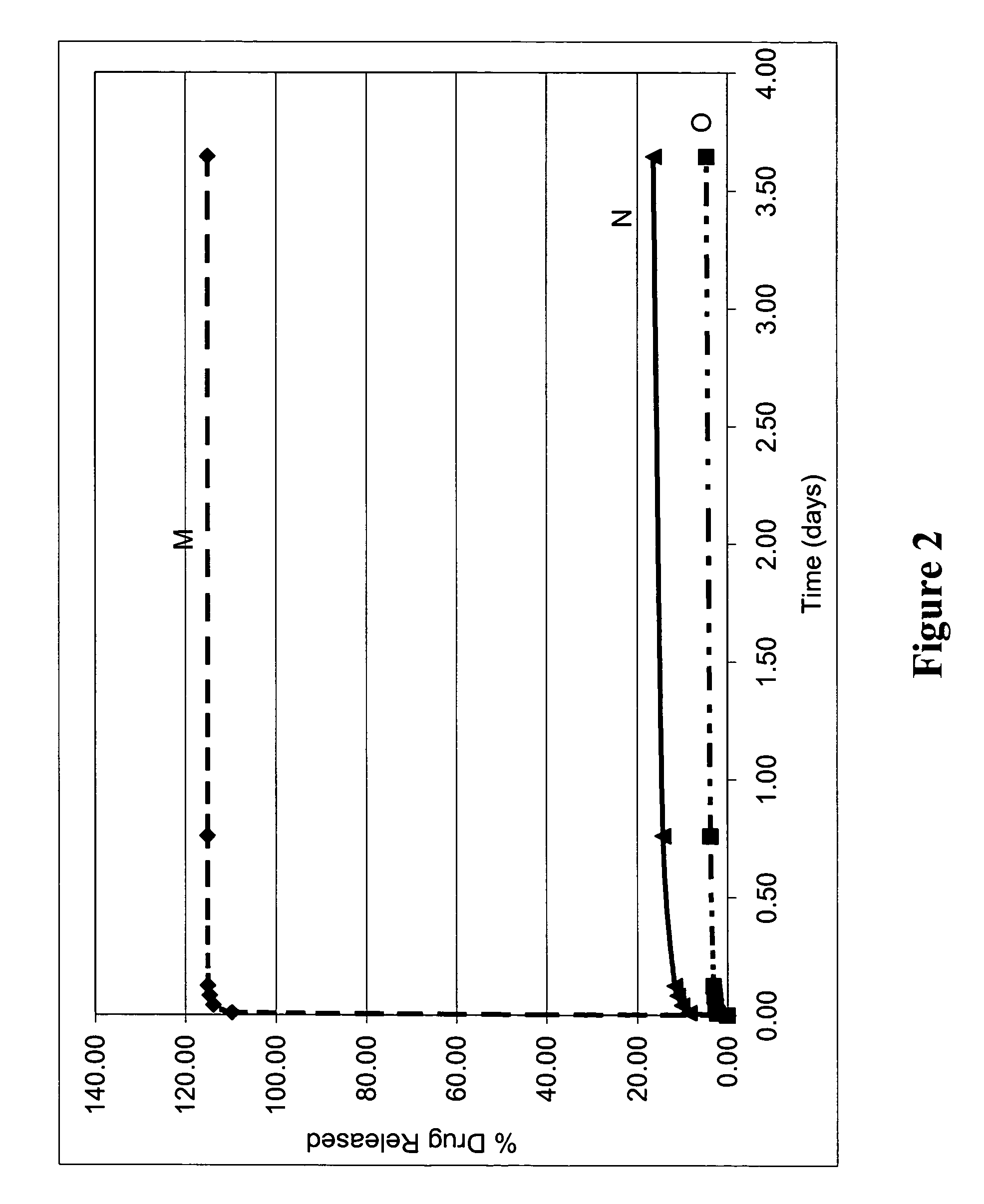Biodegradable coating compositions comprising blends
a biodegradable and coating composition technology, applied in the field of medical devices, can solve the problems of adverse reactions to medical devices, increased tissue damage, scar tissue development, and restenosis, and achieve linear bioactive agent release rates, avoid toxic levels of bioactive agents, and control the release of bioactive agents over time
- Summary
- Abstract
- Description
- Claims
- Application Information
AI Technical Summary
Benefits of technology
Problems solved by technology
Method used
Image
Examples
example 1
Elution of Bioactive Agent from Unblended PolyActive™ and PLLA Coatings Including a Single Coated Layer
[0318] To establish baseline elution profiles, coating compositions including PLLA with dexamethasone, and PolyActive™ polymer with dexamethasone, were prepared as described previously. The coating solutions were applied to the stents as described previously. The coating weights for each composition, as well as the amount of dexamethasone contained in each formulation, were approximately equivalent.
[0319] Results are shown in Table 2 and FIG. 1. Table 2 lists the coating and bioactive agent weights. Dexamethasone elution results from the coatings of Table 2 are shown in FIG. 1.
TABLE 2Coating Characteristics - UnblendedSecondLayerFirst LayerWeightDexamethasoneCoatingFirst Layer PolymerWeight (μg)(μg)Weight (μg)APLLA / Dexa486N / A54B1000PEGT80PBT20 / 521N / A52Dexa
[0320] As shown in the FIG. 1, coatings comprised of unblended PolyActive™ polymer released dexamethasone relatively quickly...
example 2
Elution of Bioactive Agent from Representative Blended Coatings Including PEGT / PBT Copolymer and PLLA
[0323] Representative blended biodegradable compositions were prepared to include a model small molecular weight drug (dexamethasone). The resulting biodegradable compositions were provided on the surface of stents and tested for elution of the bioactive agent as follows.
[0324] To prepare blended biodegradable compositions, solutions of PolyActive™ copolymer, PLLA, and dexamethasone were each dissolved in chloroform to a total solids concentration of 30 mg / ml. These solutions were applied to The stents as described previously.
[0325] The ratio of PolyActive™ copolymer to PLLA was varied to demonstrate the adjustment of the dexamethasone elution rate from each stent. Table 3 lists the coating compositions, and FIG. 2 shows the elution rate results for the blended coatings.
TABLE 3Coating CharacteristicsWeightPercentPolyActiveCoatingtoWeightDexamethasoneCoatingCoating CompositionPLL...
example 3
Elution of Bioactive Agent from Representative Blended Coatings Including PEGT / PBT Copolymer and P(LLA-CL-GLA)
[0330] Representative blended biodegradable compositions were prepared to include a model small molecular weight drug (paclitaxel). The resulting biodegradable compositions were provided on the surface of stainless steel stents and tested for elution of the bioactive agent as follows. Stents were pretreated with Parylene™ (as described herein) prior to application of biodegradable coatings.
[0331] To prepare blended biodegradable compositions, solutions of PolyActive™ copolymer, P(LLA-CL-GLA), and paclitaxel were each dissolved in chloroform to a total solids concentration of 40 mg / ml. These solutions were applied to stents as described previously.
[0332] The ratio of PolyActive™ copolymer to P(LLA-CL-GLA) was varied to demonstrate the adjustment of the PTX elution rate from each stent. Table 4 lists the coating compositions, and FIG. 3 shows the elution rate results for th...
PUM
| Property | Measurement | Unit |
|---|---|---|
| Fraction | aaaaa | aaaaa |
| Fraction | aaaaa | aaaaa |
| Fraction | aaaaa | aaaaa |
Abstract
Description
Claims
Application Information
 Login to View More
Login to View More - R&D
- Intellectual Property
- Life Sciences
- Materials
- Tech Scout
- Unparalleled Data Quality
- Higher Quality Content
- 60% Fewer Hallucinations
Browse by: Latest US Patents, China's latest patents, Technical Efficacy Thesaurus, Application Domain, Technology Topic, Popular Technical Reports.
© 2025 PatSnap. All rights reserved.Legal|Privacy policy|Modern Slavery Act Transparency Statement|Sitemap|About US| Contact US: help@patsnap.com



